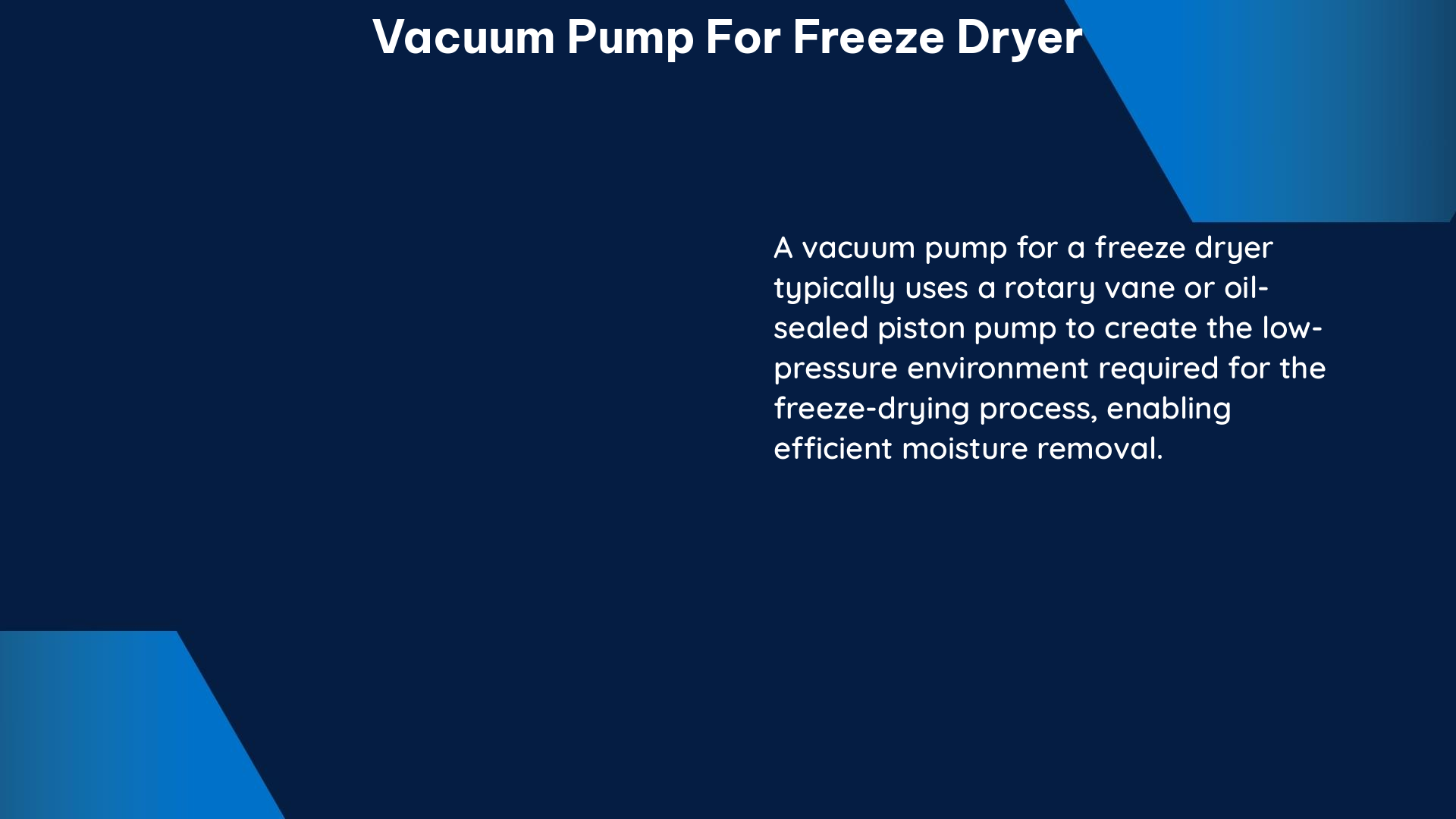A vacuum pump is a critical component of a freeze dryer, responsible for creating and maintaining the low-pressure environment necessary for the freeze-drying process. The performance of the vacuum pump directly impacts the quality and efficiency of the freeze-drying operation. In this comprehensive guide, we will delve into the technical specifications of vacuum pumps for freeze dryers and provide a detailed DIY perspective on their maintenance and troubleshooting.
Technical Specifications of Vacuum Pumps for Freeze Dryers
Types of Vacuum Pumps
The two primary types of vacuum pumps used in freeze dryers are rotary vane pumps and scroll pumps. Rotary vane pumps are more common due to their lower cost and higher pumping speed, typically ranging from 20 L/s to 250 L/s. Scroll pumps, on the other hand, offer the advantage of being oil-free, eliminating the need for oil changes and reducing maintenance requirements. Scroll pumps for freeze dryers typically have a pumping speed range of 10 L/s to 100 L/s.
Pumping Speed
The pumping speed of a vacuum pump is a crucial specification, as it determines the efficiency of water vapor removal during the freeze-drying process. For a typical freeze dryer, a pumping speed of at least 20 L/s or 70 CFM is recommended to ensure efficient sublimation of ice. High-end freeze dryers may utilize vacuum pumps with pumping speeds up to 250 L/s or 500 CFM to accommodate larger sample sizes or higher throughput.
Ultimate Vacuum
The ultimate vacuum, or the lowest achievable pressure, is another critical specification for vacuum pumps used in freeze dryers. For efficient freeze drying, a ultimate vacuum of 10^-3 mbar or lower is desirable to ensure effective sublimation of ice. Rotary vane pumps typically achieve a ultimate vacuum of 10^-3 mbar to 10^-4 mbar, while scroll pumps can reach ultimate vacuums as low as 10^-5 mbar.
Noise Level
The noise level of a vacuum pump is an important consideration, especially in laboratory or industrial settings where the freeze dryer is located. Vacuum pumps with noise levels below 60 dB(A) are preferred to minimize disruption and maintain a comfortable working environment.
Power Consumption
The power consumption of a vacuum pump can significantly impact the overall energy efficiency of a freeze dryer. Look for pumps with low power consumption, typically ranging from 0.5 kW to 5 kW, and high pumping speed to optimize energy efficiency and reduce operating costs.
Maintenance Requirements
Regular maintenance is essential to ensure the longevity and efficiency of a vacuum pump. Oil-free scroll pumps generally require less maintenance, as they eliminate the need for oil changes. Rotary vane pumps, on the other hand, may require more frequent oil changes and filter replacements, typically every 500 to 2,000 hours of operation, depending on the manufacturer’s recommendations.
DIY Perspective: Vacuum Pump Maintenance and Troubleshooting

For those considering a DIY approach to vacuum pump maintenance, it is crucial to follow the manufacturer’s guidelines and use appropriate tools and equipment. Here are some general steps to follow:
-
Check and Change Oil: Regularly check the oil level in your vacuum pump and change it as recommended by the manufacturer. Use only the recommended type and viscosity of oil. For rotary vane pumps, the oil should be changed every 500 to 2,000 hours of operation, or as specified by the manufacturer.
-
Inspect and Clean Filters: Regularly inspect and clean the air filters in your vacuum pump to ensure efficient operation. Replace filters as necessary, typically every 1,000 to 5,000 hours of operation, depending on the pump model and operating conditions.
-
Check for Leaks: Regularly check for leaks in the vacuum system, including the pump, hoses, and fittings. Use a leak detection solution or a vacuum gauge to identify any leaks and repair them promptly. Leaks can significantly reduce the pump’s efficiency and ultimate vacuum.
-
Maintain Proper Ventilation: Ensure that your vacuum pump is properly ventilated to prevent overheating and reduce the risk of fire. Provide adequate airflow around the pump and ensure that the exhaust is directed away from the freeze dryer.
-
Keep the Pump Dry: Moisture can damage the internal components of a vacuum pump, so it is essential to keep the pump dry and free from condensation. If the pump is exposed to moisture, take steps to dry it out before restarting the system.
-
Monitor Performance: Regularly monitor the performance of your vacuum pump by checking the pumping speed, ultimate vacuum, and power consumption. Compare these values to the manufacturer’s specifications to ensure the pump is operating within its designed parameters.
-
Troubleshoot Issues: If you encounter any issues with your vacuum pump, such as reduced pumping speed, high power consumption, or inability to reach the desired vacuum level, refer to the manufacturer’s troubleshooting guide or consult with a qualified technician for assistance.
By following these DIY maintenance and troubleshooting steps, you can help ensure the long-term reliability and efficiency of your vacuum pump, ultimately improving the performance and quality of your freeze-drying process.
References:
- Ganguly, A., Hardwick, L., Tchessalov, S., Nail, S. L., Dixon, D., Kanka, F., … & Pikal, M. J. (2023). Recommended Best Practices in Freeze Dryer Equipment Performance Qualification: 2022. PDA Journal of Pharmaceutical Science and Technology, 77(1), 1-20.
- EP3074707B1 (2021). Process for controlling the quality of a freeze-drying process. European Patent Office.
- Harvest Right (2022). Performing a Vacuum Test on Your Freeze Dryer. Harvest Right. Retrieved from https://harvestright.com/question/performing-vacuum-test/

The lambdageeks.com Core SME Team is a group of experienced subject matter experts from diverse scientific and technical fields including Physics, Chemistry, Technology,Electronics & Electrical Engineering, Automotive, Mechanical Engineering. Our team collaborates to create high-quality, well-researched articles on a wide range of science and technology topics for the lambdageeks.com website.
All Our Senior SME are having more than 7 Years of experience in the respective fields . They are either Working Industry Professionals or assocaited With different Universities. Refer Our Authors Page to get to know About our Core SMEs.